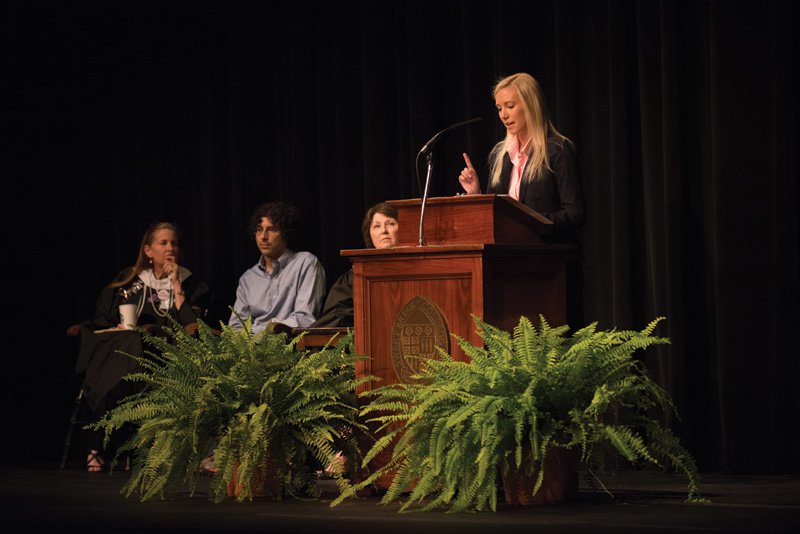
Katie Craig addresses the Sweet Briar community at the college’s 110th opening convocation Aug. 27. To her right are Pam DeWeese, interim dean of the faculty and vice president for academic affairs, and psychology professor Dan Gottlieb.
Photo by Meredith de Avila Khan
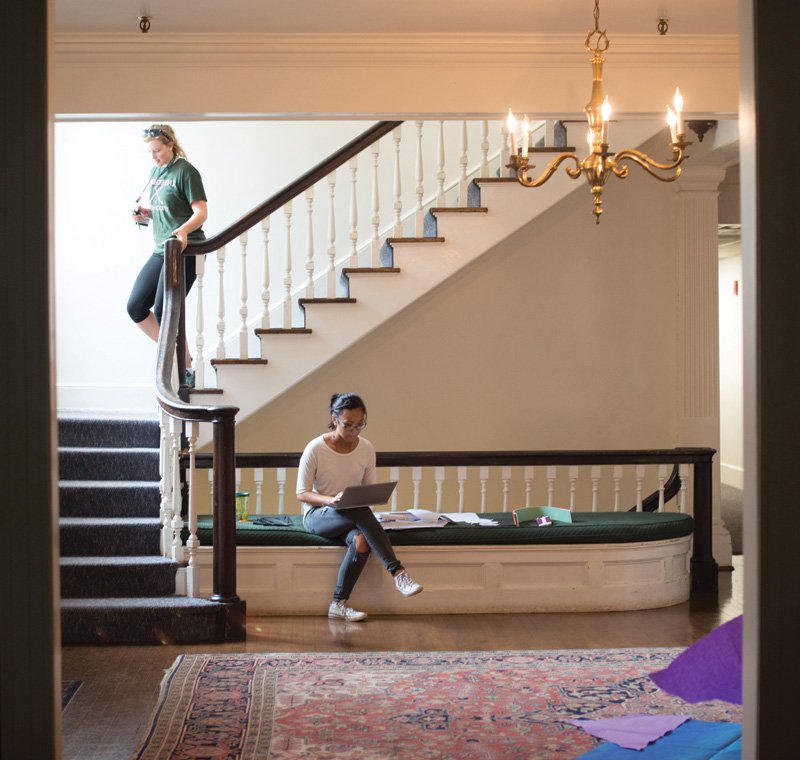
Upper class residence, Randolph Hall in 2015.
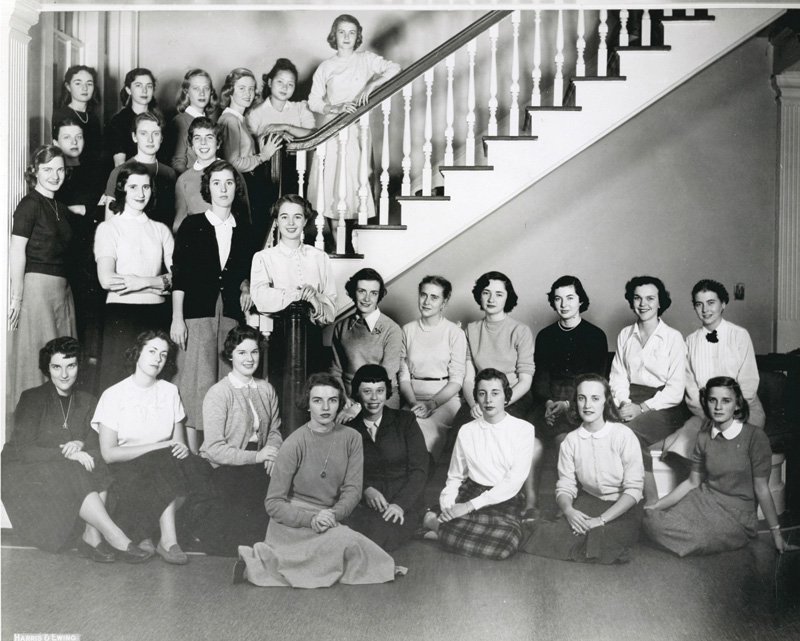
Students in Randolph Hall in 1952.

Sweet Briar women in 1908.
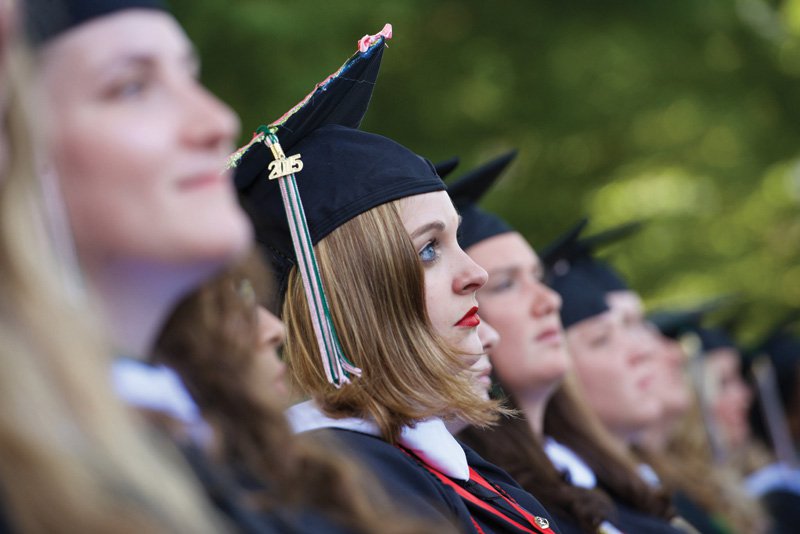
Casey Parker (’15) at the college’s 106th commencement held May 15.
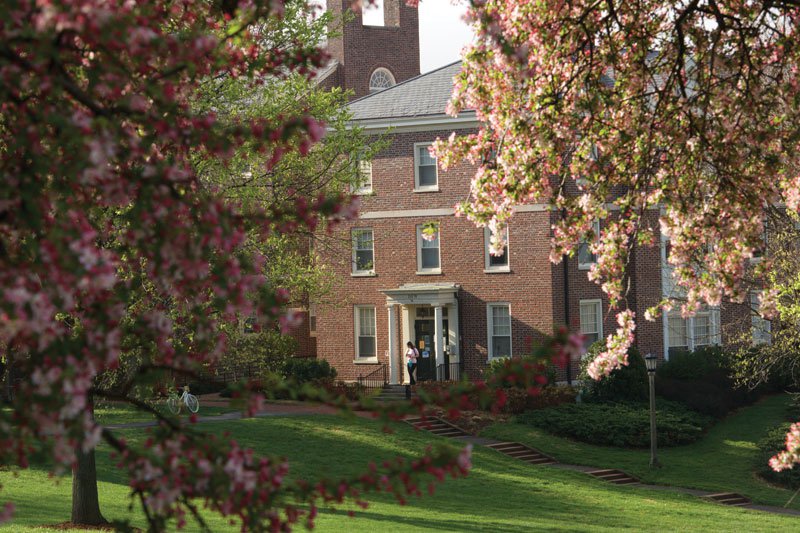
Reid Hall, a dorm for first-year students.
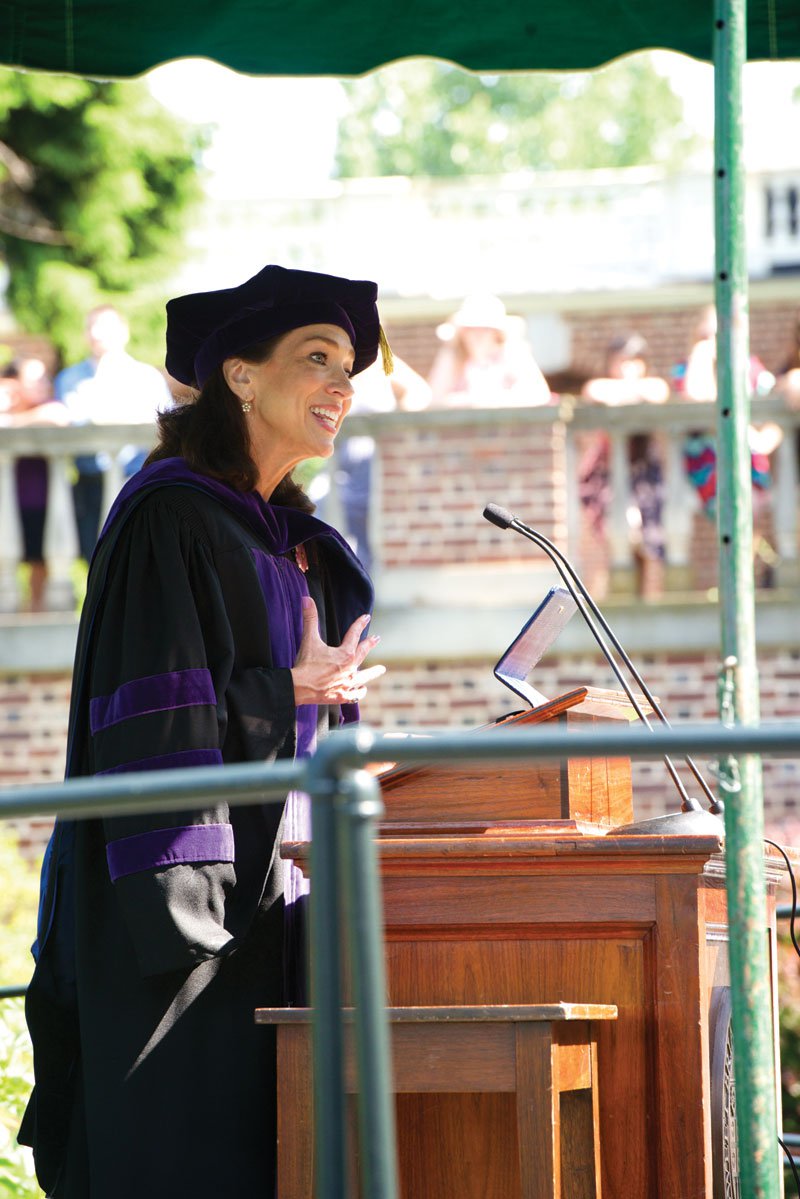
The Hon. Teresa Tomlinson (’87), mayor of Columbus, Georgia, gives the commencement address. May 15.
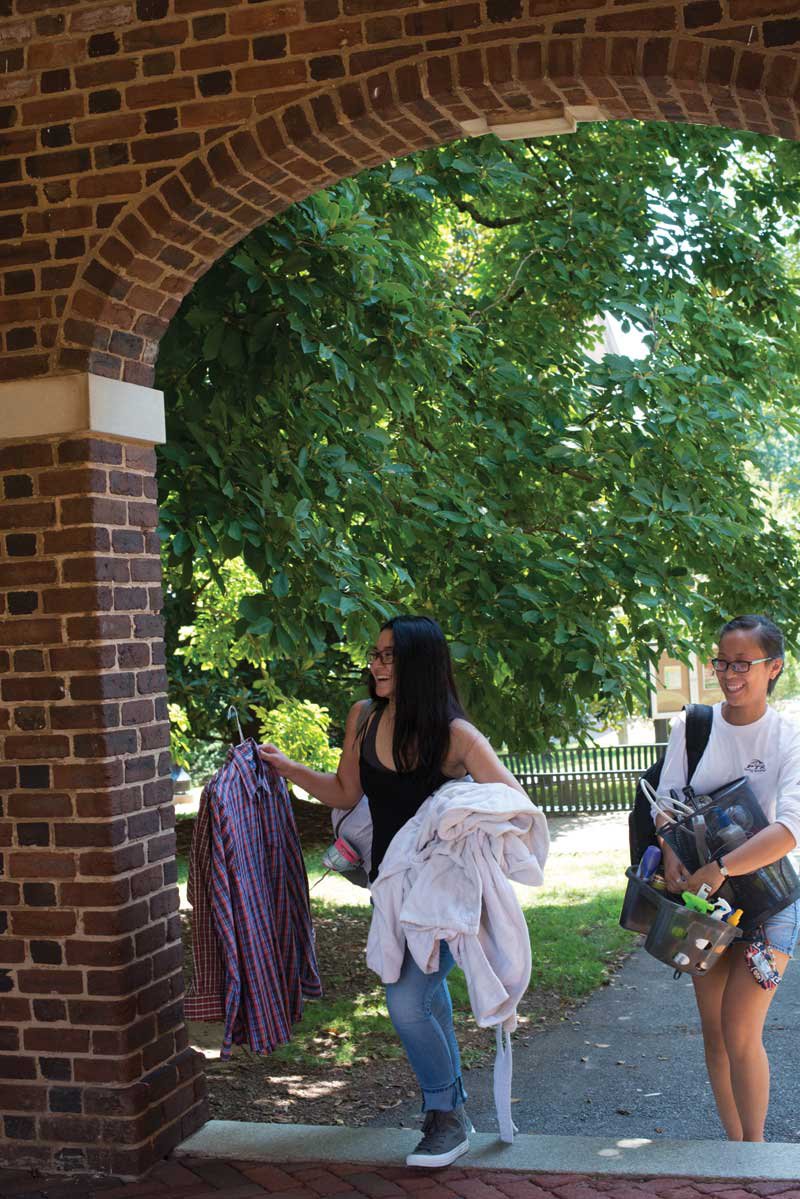
Several of the 328 students enrolled for the 2015-2016 academic year move in Aug. 23.
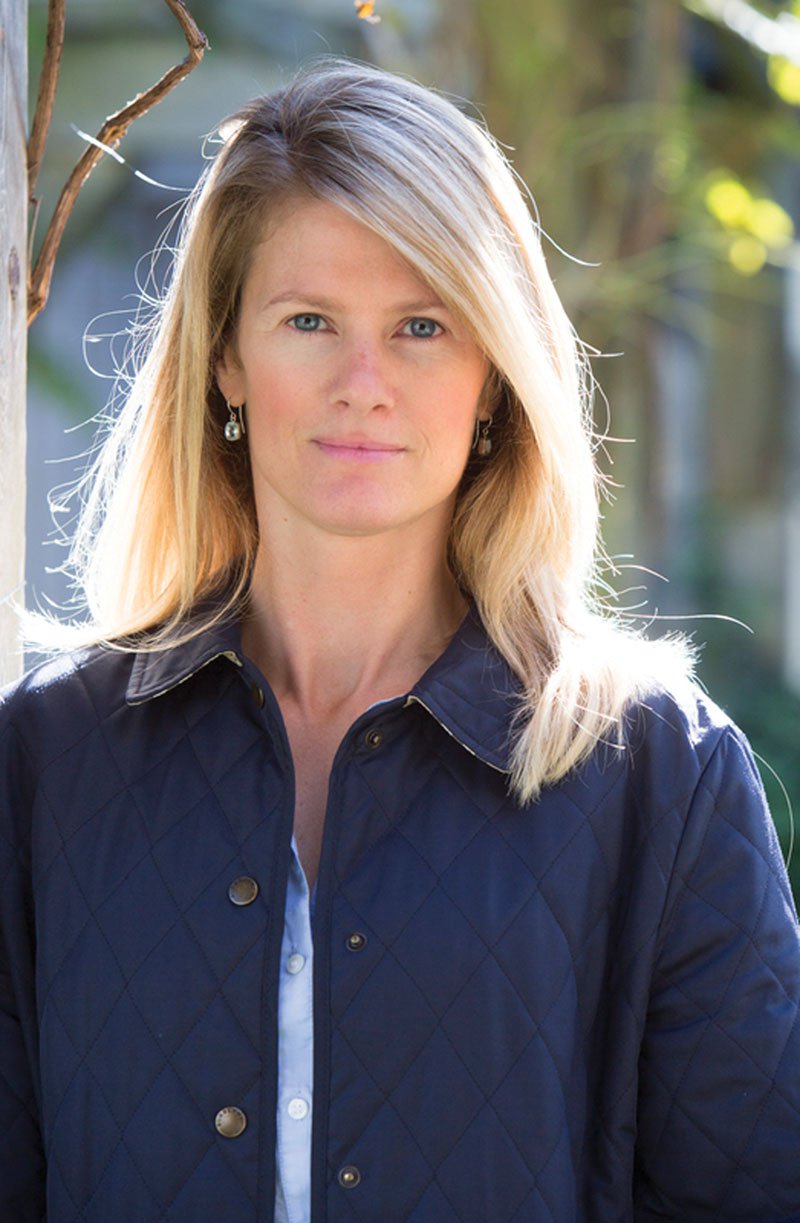
Tracy Stuart (’93) founded the non-profit organization Saving Sweet Briar to mobilize alumnae and block the board of directors’ decision to close the college after it was announced March 3.
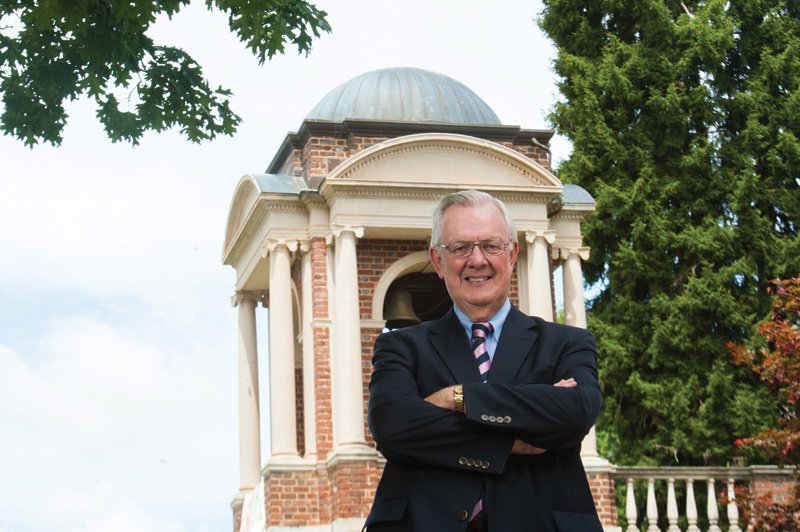
Philip C. Stone officially took office as president of Sweet Briar College July 2.
On March 3, 2015 the president of Sweet Briar College in Amherst, James F. Jones Jr., announced the 114-year old woman’s college would close in August. What follows is an accounting of the maelstrom that came in the wake of the news, and ultimately, the extraordinary alumnae-led reversal of fortune that has kept the college’s doors open. Sweet Briar women saved their school, but the question remains: Will the college survive?
March 3
As faculty and staff gathered in Sweet Briar’s Memorial Chapel around noon for a meeting called earlier that morning by then-president James F. Jones Jr., Tony Lilly felt optimistic.
Just days before, the board of directors had awarded tenure to the associate professor of English—a career milestone. He and his colleagues had received a 3 percent raise in January, and the college’s new $8.8 million library addition had been completed in October after two years of construction. He was making his plans to accompany a group of students on Sweet Briar’s annual six-week study abroad program in Oxford in July and August.
Lilly knew the college faced financial difficulties: Enrollment was down and budgets were shrinking. But there had been talk—and planning in special committees—of strategies to boost recruitment and revenue. That day, he says, “I expected the president would be announcing a new initiative.”
Instead, Jones told the group seated in the chapel’s neat wooden pews that the college was foundering. Bills for deferred maintenance and debt were mounting while enrollment was declining and the tuition discount rate was rising. The problems he said, were “insurmountable,” and the board had voted unanimously two days earlier to close.
Jones, who had only just taken the reins as president at the beginning of the academic year, said the college’s final class would graduate as scheduled in May, and then, in August, Sweet Briar College would shutter its doors, for good. The “wind down,” he assured, would be orderly.
It seemed a fait accompli.
“There was a collective gasp, then a stunned silence,” says Marcia Robertson, associate professor of English and a 27-year veteran of the faculty. Robertson describes the scene afterwards as “novelistic”—her friends and colleagues gathered in small groups on the quad, talking quietly beneath the outstretched branches of winter-stripped trees.
…
About 20 minutes later, junior Katie Craig got a phone call asking her to come right away to Sweet Briar House, the president’s residence. There, Jones and the dean of students explained to Craig—the current student government association president and a business major from Fredericksburg—that the college was closing due to financial difficulties they could no longer ignore. They asked her to walk with them into Babcock Auditorium where the student body would be gathering soon. Craig refused.
“I was mad,” she says. As leader of the SGA, “I had been the student representative on faculty and college committees. I had met with the president every month, and I didn’t know this was coming. I didn’t feel it was ethical.”
…
Stepping outside the auditorium for a moment, she met associate music professor Marcia Thom Kaley who was on her way inside. “This is wrong, this is really wrong,” Craig kept saying as they hugged.
The students assembled, Jones and other administrators made their way to the stage. When he went to speak, the microphone was dead—he had to deliver the news without it.
“We could barely hear when they told us what they thought the process might be,” says Craig. Teach-out school agreements—wherein a college agrees to accept all credit earned at the closing institution—were not yet definite. There was little information to share. Nothing was certain.
Students sobbed openly as Jones called for questions. The mic still not working, “I stood up and I said, ‘You come down into the audience and answer their questions!’” recalls Craig. “If you’re going to close our school for no good reason, you can come down here and face these students.”
A month earlier it would have been unthinkable to speak to her college president that way. But, Craig reasons, “When your college is closing you have nothing to lose.”
Outside the auditorium, snow still visible on the ground in the mottled gray light of the early spring afternoon, press, who had been alerted by the administration, waited to capture images of the shaken students. At that point, says Craig, students weren’t thinking about the larger import of the decision: “We were just trying to call our parents.”
Though students, faculty, staff and alumnae could not have known then that the announcement would spark a national conversation about the relevance and viability of small liberal arts colleges, and single sex education in particular, that moment was the beginning of what has turned out to be an extraordinary journey for this community; one that has revealed a depth of loyalty from the college’s alumnae that few suspected, and set the stage for a display of battlefield leadership that may have secured a future for the rural college affectionately known as the “pink bubble.”
…
At her home on Martha’s Vineyard the afternoon of March 3, real estate agent Tracy Stuart (’93) opened her laptop to check Facebook. “I rubbed my eyes, and said, ‘This can’t be,’” when she saw the post in her newsfeed that Sweet Briar was closing.
“Then I listened to the video message from Jimmy Jones, and I called my [college] roommate Emily.” Stuart describes phoning and messaging people she hadn’t seen in years. “It started to sink in. Why didn’t we know? There must be something wrong. And why did they do this on Facebook?” (The college had also sent a letter to alumnae that day.)
Then began a 19-hour odyssey for Stuart of phone calls, texts, Facebook messages and emails broken only by a conference call to President Jones around 7 p.m. for alumnae (a separate call for parents of current students followed). Stuart, who is originally from upstate New York and was an All-American field hockey and lacrosse player during her years as an undergrad, says the call was frustrating: “It was one hour, that’s all he gave us,” she says. “We couldn’t even ask freely, all the questions went through a facilitator.”
Jones told the 165 or so alums on the call that his administration and the board had turned over every rock, and that the college would require an endowment almost triple its current size to continue.
March 4
Through the afternoon and overnight alumnae connected via a Facebook page set up that day by Samantha Britell (’11), a graduate student at Georgetown. “It was a little chaotic,” says Stuart, but people were talking, more and more joining in by the minute as the news spread.
“Around 3 a.m., I said ‘We need a lawyer,’” recalls Stuart. She and the alums she was in contact with through that night, agreed: It just didn’t make sense. The school had a healthy $84 million endowment—shouldn’t that mean something?
By morning, Stuart was on the phone contacting old friends from Washington and Lee University and Hampden-Sydney for referrals to lawyers.
At around 4:00 p.m. March 4, lawyers Ashley Taylor and William Hurd, partners at Richmond firm Troutman Sanders offered some hope: the college operates based on a trust established by Indiana Fletcher Williams. It was her wish that a school for women be established on her then 8,000-acre plantation in remembrance of her daughter Daisy, who had died at the age of 16. If it could be established that the college, which opened in 1901, did indeed operate as a trust, its administrators would be required to get court approval to close. The trust that created the college, it seemed, might be able to save it too.
March 5
“Little by little we scratched things together,” says Stuart, who would hire crisis communications expert Eric Cote, principal of Providence, Rhode Island-based CK Communications. Cote quickly crystallized and broadcast the message.
“Getting the story out there in the mass media and spreading the message that a group of people were working together gave the story real credence and instilled confidence in alumnae from across the states,” says Stuart, who personally funded both the legal and PR efforts in the first weeks. “At first, it was like the seven stages of grieving,” she says. “Then we got mad.”
Within 48 hours of the announcement, Stuart had connected with Britell, Alysha Norbury (’10), a fellow Vineyard resident who would become Stuart’s assistant pro tem, and Brooke Linville of Boise, Idaho (who attended Sweet Briar from 2000-2002).
Linville had already launched a website to begin fundraising to fight the closure. Stuart appealed to her and Britell to combine forces; the women said yes. Stuart then called Ellen Ober Pitera, her class president who, along with faculty member Claudia Chang, an anthropology professor and one of the most senior faculty members, also joined the rapidly forming group.
March 9
By March 9 Stuart had established the 501(c)3 organization, Saving Sweet Briar, and recruited seven board members. The group’s goals were twofold: raise $20 million and do everything in its power to fight the closure.
The board included two alumna who had served on the college’s board of directors, but resigned: Jo Ann Soderquist Kramer (’64) of Essex, Vermont, a retired senior director of air and naval defense systems for General Dynamics Corp., and Christine Boulware (’77) of Chicago, director of her own executive search firm. Pitera, a former teacher, also agreed to join. Sarah Clement (’75), a federal administrative judge in Arlington, was named board chair.
“I stopped working,” says Stuart, “I was doing everything pro bono, putting my money and my sweat into the cause.”
Within days, thousands of Sweet Briar women had been mobilized around the world; and within just two weeks more than $3 million had been pledged.
“We didn’t have emails or phone numbers,” says Stuart (the college alumni office could offer no support because the database had been shut down), so a lot of the initial communication happened on social media. “I have to thank Mark Zuckerberg,” she laughs.
…
“If you had asked me, ‘Will your alumnae stand up and make this happen?’ I probably would have said no,” says Dr. Jill Granger, a tenured professor of chemistry and associate dean of academic affairs and director of the college’s honors program. “We had been told over and over by the administration that our alumnae didn’t have the capacity to give, that they were not a viable resource.”
“I wasn’t an alum that had been coming back for yearly reunions, but I loved the college,” explains Stuart. “I had no clue, if I had known, I would have stepped up. I couldn’t have imagined this in a million years.”
Soon, alumnae from across the country were showing up on campus to help, to commiserate and to try to keep up morale. “It meant a lot,” says Citlali Molina (’16) an engineering major from Pico Rivera, California, “when they would come with a donut truck or ice cream it was a small gift to alleviate the stress in our lives, which had become very tumultuous in a short amount of time.”
“Through March and April, alumnae were just so supportive,” says Granger, who first came to Sweet Briar in 1993 (her husband Rob is chair of the chemistry department). “One alum drove down from Massachusetts with her two little children and said she did it because she just wanted to be here. They were saying to us, ‘I think Sweet Briar is important, I think what you do is valuable.’ It was good to hear.”
Lawsuits to halt the school’s closure and secure severance for staff and faculty were pending, (“We hope to give you severance,” Granger says the administration told faculty and staff, “but we have to pay our creditors first”) and mediation was underway—though behind closed doors.
Students were going through hell, says Granger. They “just looked like zombies.” She describes a college fair held in the gym to facilitate transfers as “funerary.”
English professor Robertson says she and her colleagues were “madly writing recommendations” for student transfer applications. Fifteen schools would offer teach-out agreements, including all-women Hollins in Roanoke, Mary Baldwin in Staunton and Agnes Scott in Decatur, Georgia, as well as co-ed Randolph College in Lynchburg, Kettering University in Flint, Michigan, and Lynchburg College.
Molina would wait until June to decide to transfer to co-ed Elizabethtown College in Pennsylvania, which also offers an engineering degree. Though Molina was happy to finally have a plan, “It wasn’t the degree I wanted,” she confesses.
“If you really know Sweet Briar,” says Craig, who accepted an offer to attend Hollins, “you’d know you could never re-create it.”
Faculty were scrambling too. The regular academic hiring cycle begins in the fall for the following academic year, so the best most could hope for were 1-year non-tenure track appointments, which would come with deep cuts in pay, and often no benefits. (Sweet Briar salaries and health insurance would be cut off July 1.)
Granger says it was difficult watching her colleagues, many of whom had dedicated their careers to the college, lose hard-earned years of tenure, and in some cases, years of research: “It just didn’t make you feel good about your life, and your career.”
…
Saving Sweet Briar’s fundraising pressed ahead—raising money, it seemed, in direct proportion to increasing alumnae ire. The website had been set up to accept donations via PayPal, check and wire transfer, securities transfer and corporate matching gifts; the war chest of pledges grew to $21 million by mid-June.
But the central question remained. Why was this happening?
President Jones and the board attributed the need for closure to deferred maintenance needs ($28 million), debt ($25 million in bonds), declining enrollment (it had dropped to 532 in spring 2015 from a high of 647 in 2008), and a steep drop in revenue due to the increasing tuition discount rate (which had jumped from 40.8 percent of students in 2009 to 57 percent by 2014). In the past several years, when factoring in both the need-based and merit-based aid that was being awarded, no student at the college paid the full tuition and fees. In fact, net tuition revenue had dropped to about $12,000 per student by 2014 (down from $19,000 per student in 2010), says Dan Gottlieb, associate professor of psychology at Sweet Briar, who conducted his own analysis of the financial and enrollment data available.
When Jones explained the board’s rationale for closing, he noted that among the 2014 entering class, 43 percent had received Pell grants—federal money reserved for low-income undergraduates (the maximum award is $5,775 per year)—and that 37 percent were first-generation college students (this meant a growing number of students that would be less likely to be able to pay full price). He also mentioned the fact that women’s colleges in general are on the decline. Fifty years ago, there were 230 women’s colleges in the U.S.—if Sweet Briar closed the number would reduce to 44 according to the Women’s College Coalition.
The demographics of the college were changing. Jones and the board projected that the income they could reasonably expect to get from tuition combined with the current rate at which they were eating into the endowment (roughly 65 percent is restricted) to make ends meet, spelled financial ruin. Sweet Briar, he said, needed a $250 million endowment and an infusion of $10-$15 million in additional operating funds to survive.
…
Faculty, staff, students and alumnae felt blindsided by the bleak assessment of the school’s finances, and many flatly contradicted the board’s conclusion that the college was no longer financially viable.
History professor Katherine A. Chavigny told the New York Times in March that the college was “a victim of mismanagement” and that the “board had thrown in the towel.” In a commentary that appeared in the Washington Post’s online higher education section, 2007 alumna Maggie Saylor Patrick, a former college board member, refuted the administration’s claim that the closure was the product of “simple math” citing instead “something more reversible: poor leadership.”
The board that had voted for closure didn’t remain silent either. In June, Elizabeth H.S. Wyatt, then the board’s vice-chair, defended their decision to close in an opinion published in the Wall Street Journal. The board had done all it could, she wrote: They had retained an educational survey research firm to conduct market research to find new ways to increase enrollment; they looked at partnerships with other institutions, including Hollins; they discussed co-education; they cut costs and put off maintenance projects. Sweet Briar’s problems were “terminal,” read the headline.
Jones, who had served as president of Trinity College in Hartford, Connecticut for 10 years and whose wife is a 1964 Sweet Briar alumna, defended the decision as well. In April, he told Newsweek, “To allow the school to continue to function until the day we have to turn the lights out and lock the doors would have been unethical in the extreme.” He said the closure was “terrible,” but stood behind the decision as “the honorable thing to do.”
In hindsight, the Jones administration and board of directors may have actually contributed to saving Sweet Briar. In announcing the closure, they had shocked the alumnae into action.
…
In a May 3 op-ed published in the Roanoke Times, Gottlieb asserted that the college’s problems “can be most directly traced to a single decision, that of hiring Jo Ellen Parker in 2009.” The recruiting and admissions strategies initiated by Parker (who resigned in April 2014 to helm the Carnegie Museums of Pittsburgh) and the board, wrote Gottlieb, led to a “phased in but sustained drop in tuition revenue of almost 30 percent ($3 million per year).” He claimed that enrollment at Sweet Briar had not in fact been declining (citing an overall net increase between 1990 and 2014): Gottlieb concluded that Sweet Briar did not have to close. (Parker has declined to comment in detail on the situation. She released a statement June 7 to the Pittsburgh Post Gazette that read: “Sweet Briar has offered public statements clearly explaining the circumstances and considerations that led to its decision to close. I have nothing to add to those explanations.”)
Stuart and Saving Sweet Briar also commissioned an independent review of the college’s finances and reached the same conclusion. A general feeling on campus that spring was that the board could have worked to find other solutions. “Unilaterally, across the administration, they had given up,” says Craig.
May 15
By the time Teresa Pike Tomlinson (’87), who is the current mayor of Columbus, Georgia and a former attorney, took the podium at the college’s 106th graduation May 15, the Sweet Briar community was primed for a rallying cry. (Jones did not attend, citing a wish not to disrupt the ceremony because of threats of protest from faculty and alumnae if he did.)
“My remarks will not be based on nostalgia or emotionalism,” she began as the sun shone on the 117 undergraduates and their families gathered outside for the graduation.
“Giving up is always on the table,” she said. “But if you keep a fixed vision on what is possible, if you [the graduates] join us at the table, we will persevere.”
She called on graduates—whom she refused to call Sweet Briar’s “last,” but rather the “latest”—to “Never give in, never yield to force,” and to reject the “false narratives,” which she described as “ignorant,” being put forward that women’s colleges are no longer viable. She noted the “comfortable excuses” that had been proffered in the preceding months for the college’s failure.
“For those who have led us,” she concluded her speech, “endeavor to forgive them, they know not what they’ve done.”
June 22
After four months of fundraising, uncertainty and legal wrangling, on June 22, Bedford County Circuit Judge James W. Updike Jr. delivered the coup de grace to the administration’s efforts to close Sweet Briar. To a packed courtroom he announced that he had approved a mediated settlement brokered by Attorney General Mark Herring that would keep the college open next year.
The settlement called for Saving Sweet Briar to deliver $12 million in three installments to the college due July 2, Aug. 2 and Sept. 2 (the group had accrued $21 million in pledges by that time), and for the release of $16 million from the endowment. Together, the funds would cover operating costs for the 2015-2016 school year.
The case had gone all the way to the Virginia Supreme Court. On June 4 Virginia’s justices determined that the college is both a trust and a non-profit, non-stock corporation, thereby limiting the board’s ability to carry out the closure independently. They sent the case back to Judge Updike, who swiftly reviewed and signed off. All litigation was dismissed.
Other provisions in the mediation called for the removal of at least 13 members of the board of directors and the election of 18 new members (all of the previous board would resign); the appointment by the new board of a new president; and severance for faculty and staff who did not return for the 2015-2016 academic year. Those faculty who did return, and whose employment may be terminated at the close of the academic year due to programmatic changes, would also receive severance. (In return, faculty and staff were enjoined not to say anything denigrating about the process per a non-disparagement clause that is often standard in settlement agreements.)
Saving Sweet Briar declared June 22 victory day, posting on its website, “Sweet Briar Saved …. Time to Keep Your Promise.”
…
“Sweet Briar alumnae did something I as a lawyer would not have given even a 5 percent chance,” says Philip C. Stone, an attorney from Harrisonburg and the retired president of Bridgewater College, who was elected president of Sweet Briar according to the terms of the mediation agreement.
When he arrived on campus July 2, he faced an email inbox bursting with 1,800 messages and a daunting and urgent to-do list: restore food service, campus security, insurance coverage and membership in the Old Dominion Athletic Conference (ODAC). Recruit a senior leadership team and president’s council. And re-hire faculty and staff.
In what could be seen as a final salvo from the departing administration, an email went out June 30 telling them they had all been released, despite the fact that Stone was en route to the campus to take the helm. “I was furious,” says Stone. He immediately officially rehired everyone who wanted to return.
Alumnae like Tomlinson, who had been named chair of the new board of directors (which met for the first time July 6), came to campus to fill in the staffing gaps. She worked in admissions, giving tours and personally calling students to encourage them to enroll. All recruitment efforts had stopped months earlier.
“We were hands-on helping to run the college,” explains Tomlinson. “The president had no staff, there was virtually nobody there. He needed our support.”
So far Stone, who has a warm but no-nonsense demeanor, seems to be universally liked and trusted. Says Robertson, “He’s an utterly stand up guy. Kind, compassionate and smart as a whip.”
…
On a hazy hot day in early August the campus is quiet. There are few outward signs of the months of roiling that have just taken place. The new library is neat and gleaming in the midday sun. The grass has been mowed. Freshly baled hay awaits pick up in a field hemming the gravel road leading to the equestrian center and breezy hilltop cemetery where Daisy is buried, and where students go each year on Founders Day to lay flowers at the base of the angel statue that watches over her grave.
But it is not business as usual here. An unprecedented level of hands-on alumnae involvement has altered the balance of power, possibly for good.
On this day, 20-30 women are on campus working quietly on maintenance projects for Sweet Work Days—three consecutive weeks that would see nearly 150 alumnae from all over the country donning work gloves to prep for the arrival of students Aug. 23.
While Drusie Bishop (’78) of Nashville and Barbara Bagbey (’80) of Richmond patiently paint the front door of the Vixen Den, a college eatery and hang-out named for Sweet Briar’s mascot, Julia Shields (’62) of Charlottesville works to strip bulletin boards across campus, methodically pulling out the hundreds, likely thousands, of staples left there over who knows how long.
“It’s so satisfying. No one will ever notice, but I will,” says the retired high school English teacher. “I can’t do the financial part” to help, she explains, “but this is my bit.” Around her, women pick up garbage and pressure wash walkways. They mulch and trim and primp without fanfare. These are the devoted disciples of the institution.
Meanwhile, across campus, on the third floor of Fletcher, Marcia Robertson methodically unpacks the books and things from the office she had packed up just a month or so ago. Despite her 27 years at Sweet Briar, the disarray makes it look like she is just starting out.
And in many ways she is. “We’re reinventing Sweet Briar,” says Tomlinson. “We have a legacy to continue.”
August 27
On Aug. 27, when the fall term began, the college welcomed a total of 328 undergraduates, Craig and Molina among them. (Elizabethtown and Hollins refunded the student’s deposits, as did many other colleges.) Thirty of that number are freshman; the class of 2019.
They were joined by 100 full and part-time faculty members (down from 124 last spring), 16 of whom are new hires, including Lilly, Robertson, Gottlieb and Kaley. (Granger accepted a position as full tenured professor of chemistry and dean of the residential honors college at Western Carolina University. Her husband Rob elected to return to Sweet Briar.)
…
By any measure, this has been a heroic effort. But how does the college sustain it? And how does Sweet Briar leverage this newly awakened force to increase enrollment and revenue?
Tomlinson sees alumnae taking a much bigger part in visioning for the college, and wants new governing structures in place to facilitate that, including a change to the existing by-laws.
And what about Saving Sweet Briar? After it makes its final payment of $3.5 million due Sept. 2 (at press time, there was less than one million to go) will the organization have a role in the governance of the college?
“At that point we’ll have achieved what we’re required to do,” says Stuart. “It’s sort of like we’re handing over the keys. The college is up and running, we met our litigation obligation.” But, she adds, “I hope the college will say, we’d like you to continue working.” (It was announced in August that Stuart would continue her pro bono work for Sweet Briar as athletics recruiting coordinator and assistant field hockey coach.)
The bottom line is the college needs students and dollars in the door. Stone acknowledges the financial difficulty they still face and the challenges and tough decisions that lay ahead.
But, he says, “All liberal arts colleges face this. …. We’re fragile, we’ve been through a bad time. But we accept the reality of it. It’s been an old fashioned blood letting.”
Looking forward, Stone says, “We need to recruit, we have to get to 750 or 800 students.” They have the room, he notes, Sweet Briar’s 3,250 acres giving them the fourth biggest college campus in America.
Stone has indicated his intention to increase recruitment abroad, in the Emirates, he says, and East Asia and China, for example: “We want to try to target a pool who want an American education, and can pay full sticker price.”
Alumnae are poised to play a bigger role in recruiting than ever before. In fact, the alumnae story is at the heart of an emerging marketing strategy. “Sweet Briar educates some remarkable women,” says Tomlinson. “To leave them on the bench is a waste of an asset.”
As of February 2015, there were 14,096 living alumnae, of which there were 7,697 undergraduate (degreed) alumnae of record. “Some schools,” says Stone, “are not willing to use alumni except in controlled circumstances.” But I say, “let’s adjust our management style from what we were doing yesterday.”
…
“Our leadership lost faith in the mission of the college and didn’t give it appropriate value,” says Tomlinson. Even though the previous board considered the option of co-education, Tomlinson is unequivocal: “We are unapologetically a woman’s college, it’s our major strength. I’m only able to do the things I do because of the woman Sweet Briar made me.
“The current leadership believes there is interest, worth and value to this educational experience. We intend that Sweet Briar will be an educational experience that will be in high demand.”
Says Robertson, “This is the place where alums saved their college—do you want to be one of these women? Are you good enough?” SBC.edu, SavingSweetBriar.com
Update: Saving Sweet Briar made its final payment to the college Sept. 2 in the amount of $3.643 million, bringing the total amount of the group’s contribution to $12.143 million.
Correction: An earlier version of this story stated that 328 undergraduates arrived on campus Aug. 27 for the start of the fall semester. It should be noted that of those 328 students, 80 were enrolled in study abroad programs.









